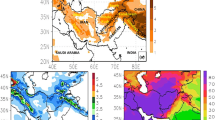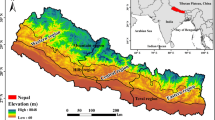Abstract
Based on daily precipitation data from 109 stations in the Yangtze River Basin (YRB) over the past 36 years (1980`-2015), the Empirical Orthogonal Function (EOF) is employed to analyze changes in autumn precipitation. We used the monthly mean re-analysis datasets of atmospheric circulation and sea surface temperature (SST) to investigate the possible causes of the two leading modes, based on which the predictive equations were constructed and tested. The results of the EOF analysis show that the variance contribution of the first mode is 31.07%, and the spatial distribution shows a uniform variation over the whole region. The variance contribution of the second mode is 15.02%, and the spatial distribution displays a north-south dipole pattern in the YRB. The leading mode shows a dominant interannual variation, which is mainly due to the West Pacific subtropical high and anticyclones over the Philippine islands. The SST field corresponds to the positive phase of the eastern Pacific El Niño and the tropical Indian Ocean dipole. The second mode may be related to the Indian Ocean-East Asian teleconnection and early withdrawal of the summer monsoon. The SST field corresponds to a weaker central Pacific El Niño. Through a stepwise regression analysis, SST anomalies in some areas during summer show a good predictive effect on the autumn precipitation mode in the YRB region.
Similar content being viewed by others
References
Bai, H. Z., and Dong, W. J., 2004. Climate features and formation causes of autumn rain over Southwest China. Plateau Meteorology, 23(6): 884–889.
Chen, Y., and Shi, N., 2006. El Niño/ENSO and Climatic Anomaly in the Autumn of China. Journal of Tropical Meteorology, 19(2): 137–146.
Drbohlav, H. K. L., Gualdi, S., and Navarra, A., 2007. A diagnostic study of the Indian Ocean dipole mode in El Niño and non-El Niño years. Journal of Climate, 20(13): 2961–2977.
Guo, Y. R., Tian, M. K., Chen, Y., and Guo, S. C., 2019. Influence of autumn Eurasian wave train on precipitation and surface temperature of China. Journal of Yunnan University: Natural Sciences Edition, 41(4): 746–752.
He, M., 1984 Distribution and long-term forecast of main autumn rain area in China. Meteorological Monthly, 10(9): 10–13.
He, S. S., Zhang, W. J., Qi, L., and He, J. H., 2015. Contrasting SST anomalies over the Indian Ocean between the two types of El Niño events during boreal autumn. Acta Meteorologica Sinica, 73(3): 515–528.
Huang, R. H., Chen, J. L., Huang, G., and Zhang, Q. L., 2006. The Quasi-Biennial Oscillation of summer monsoon rainfall in China and its cause. Chinese Journal of Atmospheric Sciences, 30(4): 545–560.
Jia, X. L., Zhang, P. Q., Chen, L. J., Gao, H., Zhu, Y. F., Li, W., et al., 2008, Causality analysis of autumn rainfall anomalies in China in 2007. Meteorological Monthly, 34(4): 86–94.
Li, S., Feng, G., Hou, W., and Cheng, J., 2019. Characteristics of atmospheric circulation patterns over East Asia and their impacts on precipitation in summer. Climate Research, 78: 117–133, https://doi.org/10.3354/cr01544.
Liu, F., Ouyang, Y., Wang, B., Yang, J., Ling, J., and Hsu, P.-C., 2020. Intraseasonal variability of China summer precipitation: Seasonal evolution and potential predictability. Climate Dynamics, 54: 4641–4655.
Liu, X. F., and Yuan, H. Z., 2006. Effects of ENSO on the relationship between IOD and autumn rainfall in China. Journal of Nanjing Institute of Meteorology, 29(6): 762–768.
North, G. R., Bell, T. L., and Cahalan, R. F., 1982. Sampling errors in the estimation of empirical orthogonal functions. Monthly Weather Review, 110(7): 699–706.
Reis, S., Pinder, R., Zhang, M., Lijie, G., and Sutton, M., 2009. Reactive nitrogen in atmospheric emission inventories. Atmospheric Chemistry and Physics, 9: 7657–7677, DOI: https://doi.org/10.5194/acp-9-7657-2009.
Shen, Y., 2001. A study on the climatic anomaly feature in autumn in China and analysis of it’s cause. Master thesis. Nanjing University of Information Science & Technology.
Wang, B., Wu, R. G., and Fu, X. H., 2000. Pacific-East Asian teleconnection: How does ENSO affect East Asian climate? Journal of Climate, 13: 1517–1536.
Wang, L., and Feng, J., 2011. Two major modes of the wintertime precipitation over China. Chinese Journal of Atmospheric Sciences, 35(6): 1105–1116 (in Chinese with English abstract).
Wei, F. Y., 2006. Relationships between precipitation anomaly over the middle and lower reaches of the Changjiang River in summer and several forcing factors. Chinese Journal of Atmospheric Sciences, 30(2): 202–211 (in Chinese with English abstract).
Xie, S. P., and Hu, K. P., 2008. Indian Ocean capacitor effect on Indo-western Pacific climate during the summer following El Niño. Journal of Climate, 22(18): 730–747.
Xu, L. Y., and Jian, Y. D., 2005, Characteristics of weather and climate in China during 2004. Meteorology Monthly, 31(4): 35–38.
Zheng, J., Liu, Q., Wang, C., and Zheng, X. T., 2013. Impact of heating anomalies associated with rainfall variations over the Indo-western Pacific on Asian atmospheric circulations in winter. Climate Dynamics, 40(7–8): 2023–2033.
Acknowledgements
We appreciate use of the reanalysis data provided by the European Center for Medium-Range Weather Forecasts and the daily precipitation data released by the China Meteorological Administration. This work is supported by the National Natural Science Foundation of China (NSFC) (Nos. 41975061 and 41605037).
Author information
Authors and Affiliations
Corresponding author
Rights and permissions
About this article
Cite this article
Qian, H., Xu, S. & Wu, X. Analysis of the Leading Modes of Autumn Precipitation over the Yangtze River Basin. J. Ocean Univ. China 20, 803–810 (2021). https://doi.org/10.1007/s11802-021-4437-5
Received:
Revised:
Accepted:
Published:
Issue Date:
DOI: https://doi.org/10.1007/s11802-021-4437-5




